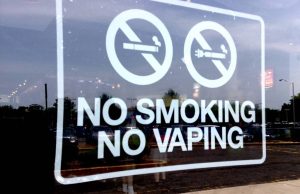 This post was written by Janelle Langan, an LL.M. in Global Health Law candidate at Georgetown University Law Center. Any questions or comments about the post should be directed to jl2009@georgetown.edu.
This post was written by Janelle Langan, an LL.M. in Global Health Law candidate at Georgetown University Law Center. Any questions or comments about the post should be directed to jl2009@georgetown.edu.
The rebellious, rugged images of the Marlboro Man linked the idea of smoking filtered Marlboro cigarettes with masculinity to promote tobacco sales at the cost of public health. The idea of glamorizing tobacco use is nothing new. However, over the past decade, the regulation of tobacco products as well as increased awareness has helped to educate consumers on the dangers of smoking in order to protect public health. Until recently, the popularity of electronic cigarettes (e-cigarettes) was largely driven by the lack of regulation upon its use and marketing. E-cigarettes have been a controversial topic since they entered the marketplace nearly a decade ago.
E-cigarettes are composed of a battery, a nicotine cartridge, and an atomizer. Through “vaping,” nicotine is delivered in an aerosol form that is exhaled by the user in vapor form, which e-cigarette manufacturers market as a healthier alternative to traditional cigarettes. Confusion surrounding the categorization of e-cigarettes created a wild west-like environment that contributed to its popularity. Unlike smokers who are stigmatized and banished to remote, unpleasant, outdoor locations, vaping was often permitted inside public areas. Additionally, manufacturers were able to target younger audiences through marketing practices that included advertising at sporting events and providing free samples.
Under the Food, Drug, and Cosmetic Act, as amended by the Family Smoking Prevention and Tobacco Control Act, the Food and Drug Administration (“FDA”) was granted the power to regulate the sale and distribution of “tobacco products,” which specifically includes cigarettes, cigarette tobacco, roll-your-own tobacco, and smokeless tobacco. In order for the FDA to regulate other forms of tobacco products, it must “deem” the product within its regulatory authority.
The degree to which e-cigarettes should be regulated has been the source of a vigorous debate. Some advocate for minimal regulations because e-cigarettes may help smokers reduce or cease nicotine consumption. However, the level of nicotine varies greatly depending upon the product’s characteristics, user’s puffing behavior, and nicotine solution concentration. Thus, others advocate for harsher regulations, arguing that e-cigarettes contain addictive and harmful ingredients that pose significant public health risks.[1]
This past week, the FDA expanded the definition of “tobacco products” to deem electronic nicotine delivery systems (“ENDS”) within its regulatory authority. ENDS specifically includes: e-cigarettes, e-cigars, e-hookah, vape pens, personal vaporizers, and electronic pipes. In addition to expanding the definition of tobacco products, the FDA issued the following consumer-based restrictions:
- E-cigarettes will not be allowed to be sold to anyone under the age of 18;
- Those under the age of 27, must provide identification when purchasing e-cigarettes;
- E-cigarettes may not be sold in vending machines, unless the machine is located in an adult-only facility; and
- E-cigarettes will not be distributed to consumers through free samples.
These restrictions, which take effect in 90 days, are aimed at reducing e-cigarette use amongst young consumers as nicotine exposure during adolescence may adversely affect brain development. Beyond these regulations, manufacturers are subject to additional regulations, which include: registering manufacturing establishments and providing product listings; reporting ingredients, and harmful and potentially harmful constituents; undergoing premarket review and authorization of new tobacco products; placing health warnings on product packages and advertisements; and not selling modified risk tobacco products including those described as “light,” “low,” or “mild” unless authorized by the FDA.
The new regulations are aimed at striking a delicate balance between deterring young tobacco use without preventing the use of a product that may aid traditional smokers in reducing or ceasing nicotine use. This recent action by the FDA: (1) makes a preliminary step forward by creating much needed regulation upon the use of electronic nicotine delivery systems and (2) focuses upon requiring more data on the nature of health risks posed by the use of electronic nicotine delivery systems.
[1] See, e.g. Martin McKee, Electronic Cigarettes: Proceed with Great Caution, 59 Int’l J. Pub. Health 683, 684 (2014).



